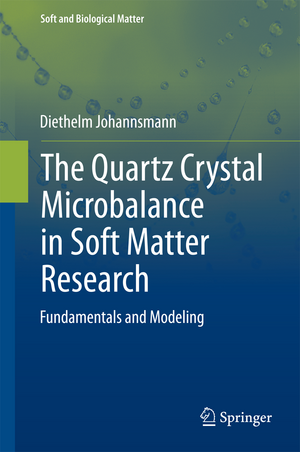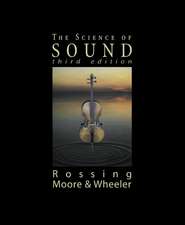The Quartz Crystal Microbalance in Soft Matter Research: Fundamentals and Modeling: Soft and Biological Matter
Autor Diethelm Johannsmannen Limba Engleză Hardback – aug 2014
From a device for measuring film thickness in vacuum, the quartz crystal microbalance (QCM) has in the past two decades evolved into a versatile instrument for analyzing soft matter at solid/liquid and solid/gas interfaces that found applications in diverse fields including the life sciences, material science, polymer research and electrochemistry. As a consequence of this success, the QCM is now being used by scientists with a wide variety of backgrounds to study an impressive diversity of samples, with intricate data analysis methods being elaborated along the way. It is for these practitioners of the QCM that the book is written. It brings across basic principles behind the technique and the data analysis methods in sufficient detail to be educational and in a format that is accessible to anyone with an undergraduate level knowledge of any of the physical or natural sciences. These principles concern the analysis of acoustic shear waves and build on a number of fundamental physical concepts which many users of the technique do not usually come across. They have counterparts in optical spectroscopy, electrical engineering, quantum mechanics, rheology and mechanics, making this book a useful educational resource beyond the QCM itself. The main focus is the physics of QCM, but as the book describes the behavior of the QCM when exposed to films, droplets, polymer brushes, particles, vesicles, nanobubbles and stick-slip, it also offers insight into the behavior of soft matter at interfaces in a more general sense.
| Toate formatele și edițiile | Preț | Express |
|---|---|---|
| Paperback (1) | 1113.09 lei 6-8 săpt. | |
| Springer International Publishing – 17 sep 2016 | 1113.09 lei 6-8 săpt. | |
| Hardback (1) | 1119.24 lei 6-8 săpt. | |
| Springer International Publishing – aug 2014 | 1119.24 lei 6-8 săpt. |
Din seria Soft and Biological Matter
- 15%
 Preț: 652.17 lei
Preț: 652.17 lei - 18%
 Preț: 743.11 lei
Preț: 743.11 lei - 15%
 Preț: 642.18 lei
Preț: 642.18 lei -
 Preț: 372.11 lei
Preț: 372.11 lei -
 Preț: 389.70 lei
Preț: 389.70 lei - 15%
 Preț: 592.61 lei
Preț: 592.61 lei - 15%
 Preț: 833.35 lei
Preț: 833.35 lei - 15%
 Preț: 656.89 lei
Preț: 656.89 lei - 20%
 Preț: 572.40 lei
Preț: 572.40 lei - 18%
 Preț: 1115.14 lei
Preț: 1115.14 lei - 18%
 Preț: 1012.46 lei
Preț: 1012.46 lei -
 Preț: 389.49 lei
Preț: 389.49 lei - 18%
 Preț: 943.77 lei
Preț: 943.77 lei - 18%
 Preț: 735.84 lei
Preț: 735.84 lei - 18%
 Preț: 789.52 lei
Preț: 789.52 lei - 18%
 Preț: 1010.17 lei
Preț: 1010.17 lei - 18%
 Preț: 952.09 lei
Preț: 952.09 lei
Preț: 1119.24 lei
Preț vechi: 1364.93 lei
-18% Nou
Puncte Express: 1679
Preț estimativ în valută:
214.16€ • 223.60$ • 177.25£
214.16€ • 223.60$ • 177.25£
Carte tipărită la comandă
Livrare economică 04-18 aprilie
Preluare comenzi: 021 569.72.76
Specificații
ISBN-13: 9783319078359
ISBN-10: 3319078356
Pagini: 387
Ilustrații: XX, 387 p. 123 illus., 9 illus. in color.
Dimensiuni: 155 x 235 x 22 mm
Greutate: 0.74 kg
Ediția:2015
Editura: Springer International Publishing
Colecția Springer
Seria Soft and Biological Matter
Locul publicării:Cham, Switzerland
ISBN-10: 3319078356
Pagini: 387
Ilustrații: XX, 387 p. 123 illus., 9 illus. in color.
Dimensiuni: 155 x 235 x 22 mm
Greutate: 0.74 kg
Ediția:2015
Editura: Springer International Publishing
Colecția Springer
Seria Soft and Biological Matter
Locul publicării:Cham, Switzerland
Public țintă
ResearchCuprins
Preface.- 1 Introduction.- 2 Methods of Read-Out.- 3 Essentials of Viscoelasticity.- 4 Modeling the Resonator as a Parallel Plate.- 5 Piezoelectric Stiffening.- 6 The Small Load Approximation Revisited.- 7 Energy Trapping and its Consequences.- 8 Gravimetric Sensing.- 9 Homogeneous Semi-Infinite Samples.- 10 Stratified Layer Systems.- 11 Point Contacts and Contact Stiffness.- 12 Heterogeneous Samples.- 13 Nonlinear Interactions.- 14 Practical Consequences of Piezoelectric Stiffening.- 15 Other Surface-Acoustic-Wave Based Instruments.- 16 Combined Instruments.- 17 Considerations for Well-Controlled QCM Experiments.- 18 Collection of Essential Equations.
Notă biografică
Prof. Dr. Diethelm Johannsmann, born 1962, received his physics education in Bonn and Heidelberg. From 1988 to 1991 he worked on his PhD thesis at the Max-Planck-Institute (MPI) for polymer research, Mainz, Germany and subsequently became a postdoc at the UC Berkeley, USA. After 2 years he joined the MPI for polymer research again, now as a member of the scientific staff. As of 2002 he is associate professor and teaches physical chemistry at Clausthal University of Technology, Germany.
His research interests encompass acoustic resonators, soft matter at interfaces, polymer surfaces and polymer films, novel sensing schemes and contact mechanics.
He has contributed to QCM-based research over the past 25 years with more than 50 publications and is an acknowledged expert in the field.
His research interests encompass acoustic resonators, soft matter at interfaces, polymer surfaces and polymer films, novel sensing schemes and contact mechanics.
He has contributed to QCM-based research over the past 25 years with more than 50 publications and is an acknowledged expert in the field.
Textul de pe ultima copertă
This book describes the physics of the second-generation quartz crystal microbalance (QCM), a fundamental method of analysis for soft matter at interfaces.
From a device for measuring film thickness in vacuum, the quartz crystal microbalance (QCM) has in the past two decades evolved into a versatile instrument for analyzing soft matter at solid/liquid and solid/gas interfaces that found applications in diverse fields including the life sciences, material science, polymer research, and electrochemistry. As a consequence of this success, the QCM is now being used by scientists with a wide variety of backgrounds to study an impressive diversity of samples, with intricate data analysis methods being elaborated along the way. It is for these practitioners of the QCM that the book is written. It brings across basic principles behind the technique and the data analysis methods in sufficient detail to be educational and in a format that is accessible to anyone with an undergraduate level knowledge of any of the physical or natural sciences. These principles concern the analysis of acoustic shear waves and build on a number of fundamental physical concepts which many users of the technique do not usually come across. They have counterparts in optical spectroscopy, electrical engineering, quantum mechanics, rheology, and mechanics, making this book a useful educational resource beyond the QCM itself. The main focus is the physics of QCM, but as the book describes the behavior of the QCM when exposed to films, droplets, polymer brushes, particles, vesicles, nanobubbles, and stick-slip, it also offers insight into the behavior of soft matter at interfaces in a more general sense.
From a device for measuring film thickness in vacuum, the quartz crystal microbalance (QCM) has in the past two decades evolved into a versatile instrument for analyzing soft matter at solid/liquid and solid/gas interfaces that found applications in diverse fields including the life sciences, material science, polymer research, and electrochemistry. As a consequence of this success, the QCM is now being used by scientists with a wide variety of backgrounds to study an impressive diversity of samples, with intricate data analysis methods being elaborated along the way. It is for these practitioners of the QCM that the book is written. It brings across basic principles behind the technique and the data analysis methods in sufficient detail to be educational and in a format that is accessible to anyone with an undergraduate level knowledge of any of the physical or natural sciences. These principles concern the analysis of acoustic shear waves and build on a number of fundamental physical concepts which many users of the technique do not usually come across. They have counterparts in optical spectroscopy, electrical engineering, quantum mechanics, rheology, and mechanics, making this book a useful educational resource beyond the QCM itself. The main focus is the physics of QCM, but as the book describes the behavior of the QCM when exposed to films, droplets, polymer brushes, particles, vesicles, nanobubbles, and stick-slip, it also offers insight into the behavior of soft matter at interfaces in a more general sense.
Caracteristici
First book dedicated to the application of QCM to soft matter samples A must-have for scientists working on interface analysis Broadens our understanding of the structure and behaviour of soft matter at interfaces Written by a highly acknowledged expert in the field Includes supplementary material: sn.pub/extras














